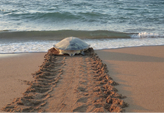Tips and Advice for Turtle season
The Mackerel Islands and Onslow are hot spots for turtle breeding and turtles are highly active in the area during turtle nesting season, between October to March.
Female turtles usually nest at night, crawling up the beach between two to three hours either side of the evening high tide.


Images and Code of Conduct courtesy of the Department of Biodiversity, Conservation and Attractions (DBCA).
Please adhere to the following guidelines to protect turtles during the nesting season:
- Check the tide times and heights before heading to the beach.
- Drive on the hard sand as close to the water’s edge as possible (below that day’s high tide line). This will reduce the risk of driving over turtles nests, which crush the eggs below, or leaving tyre tracks that become an obstacle and confuse hatchlings.
- If the tide is high and there is no hard sand to drive on, beachgoers are advised to refrain from driving and instead walk along the beach.
- Do not drive on the beach after sunset or before dawn.
- If you see a turtle on the beach, stop and turn back if possible, or wait for the turtle to be high on the beach and “bodypitting” (digging) before slowly passing.
- Follow the directional signs in the area that clearly indicate to all beachgoers where vehicles are allowed to drive.
Other ways beachgoers can protect turtles include:
- Keeping all dogs on a lead between November to March to protect nesting adults and hatchlings.
- Reducing the use of artificial lights, such as torches or flash photography, around adult and hatchling turtles to reduce disorientation and stress.
- A head torch with a red light can be used.
- Reducing any deep tracks or obstacles in the sand (like sand castles) for hatchlings.
- Leaving hatchlings to make their own way to the
ocean.
